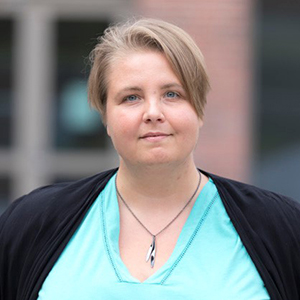The working life connection challenges and enriches
The writing and rhetoric courses for engineers challenge Linda Söderlindh at the Department of Learning in Engineering Sciences at the ITM School. But they also enrich KTH students at Linda’s regular courses.

What motivates you to create courses for professionals?
”I like the challenge of finding new perspectives on my teaching. Replacing the target group is such a change of perspective. It is both exciting and challenging to create courses for professionals. It is a group that may not have studied for a long time, which may be one of the challenges, because they may therefore have different expectations on education and training.”
”Professionals also have a lot of practical experience that will be used in the discussions during the course. They ask other questions and can also relate both theory and practice to real life situations in the workplace. Since the participants also have different experiences, the discussions will be extra fun and challenging for me as a teacher. This also enriches my “ordinary” teaching. I use many examples from my further training courses for programme students at KTH. They always appreciate these links with working life.”
Why have you initated these courses?
”In general, it is important to spread knowledge from KTH to the surrounding society. A degree does not mean that you stop learning things, quite the opposite. Most of us, and perhaps professional engineers in particular, need skills development and further training in relevant areas.”
”Communication in speech and writing are important skills for all engineers. Many may not have been able to develop these skills during their studies, or may face different demands in their working lives than those that were made during their education. That is why it is important for us to provide courses that are also relevant for engineers.”
Who is signing up?
”At least half of the participants in the rhetoric course for digital presentations are students at KTH, which was not really the idea because the courses were created for professional engineers. From “the right target group” we had everything from technical salespeople and managers to people who are not engineers themselves but who work with engineers, such as economists or human resources officers.”
”More than half of the participants in the advanced education rhetoric course are KTH students. However, we suspect that this has led to a decrease in the number of applicants for our ”regular” rhetoric course at KTH. We have tried to remedy this by requiring 180 credits in the course syllabus in order to be eligible for the course.”
”In the writing course for engineers there is almost exclusively KTH students, which was not the intention either. But many register and then never show up. Depending on when during the semester the courses take place, there may be quite a few months between the application period and the start of the course.”
What is the biggest challenge in putting together and run a course?
”These require a little different preparation than you might be used to. For example, participants may never have seen a learning platform like Canvas before, which requires more information for participants from your side. It can also be difficult at first to adapt the course to the target group because you do not know in advance who will apply. But that is also what is fun.”
”Practical things also require a little more, or different, planning. For example, the number of places in the courses must be decided in advance. Think through how many participants you want, as it is difficult to add more later, even if there is a big demand. It is also challenging to get a schedule that suits all participants. You have to try it out. Also, make sure that the course administration knows what kind of course it is, that can make it easier for both you and the participants.”
Text: Anna Gullers
